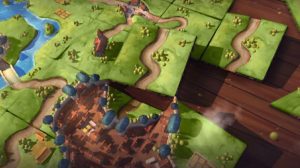Disclosure: Meeple Mountain received a free copy of this product in exchange for an honest, unbiased review. This review is not intended to be an endorsement.
Sometimes referred to in the plural as “Las Alpujarras”, the Alpujarra region is located on the southern slopes of the Sierra Nevada mountain range in Andalusia, Spain. The runoff from the Sierra Nevada’s melting snow provides the southern slopes with an abundance of fertile soil—a perfect place to start a civilization.
To quote the rule book: “During the great Arab Agricultural Revolution [in the 8th to 13th centuries] the hardworking Berber people from North Africa transformed the landscape of the Alpujarras into a world of bounty. With their innovative irrigation and terracing techniques, they brought water to the hillsides to create fertile farmlands.”
Their efforts were so successful, in fact, that multiple wars have been fought for control of the region, the most recent conflict ending in 1942. Thankfully, its days of conflict and strife seem to have passed. Today, Las Alpujarras stands as a beacon for tourists who come to see and experience its natural beauty.
Overview
In the game of Alpujarras, the players take on the roles of fruit tree farmers, working the land and delivering their goods to the surrounding villages. Played on a time track, players will take turns moving their pawns along the path and taking actions in order to place farmers in the fields, irrigate the fields to make them fruitful, harvest the goods, and deliver them to the villages. Each village wants different products in varying quantities, and pays accordingly. The larger the demand, the larger the payout. There are also methods in place for scoring additional bonuses along the way.
Once each of the players has reached the end of the time track, the game comes to an end. Final scoring is performed, and the person with the most money at the game’s end is declared the winner.
Of course, this is just a high-level overview of the game. If you think you’ve heard enough and just want to know what I think, feel free to skip ahead to the Thoughts section. Otherwise, read on as we learn how to play Alpujarras.
Setup
A game of Alpujarras is set up thusly:

First, the game board is laid out and surrounded by Action tracks, with the “Go” track at the beginning, the “End” track at the end, and an alternating lineup of Market and Harvest tracks in between. Then, each town is populated with a number of Delivery tokens and an Award token. Five Goal cards are randomly selected and placed alongside the board. The Crop tokens are placed into the bag. The remaining items—fruit, Channel tokens, coins, and norias (more on this later)—are kept in a general supply closeby.
Players choose a color and receive the farmers, mule, and Reference card of their chosen colors. The mules are gathered up and randomly placed into the starting spaces on the “Go” track. Now, you’re ready to play Alpujarras.
Playing the Game
In Alpujarras, the players take turns moving their mules along the tracks that surround the board, performing the actions of the spaces on which they place their mules. No two mules may ever occupy the same space, and your turn isn’t over until your mule has surpassed someone else’s. Then, it’s the turn of whoever is at the back of the pack.
It’s worker placement with a time track twist.
In Alpujarras, the objective is simple: end the game with the most money. Each action along the way will assist you in this endeavor, but , for the most part, each action is predicated on some other action having been completed before it. That’s where the game’s challenge comes from. Skip ahead too far to grab up a juicy action before someone else and you might hamstring yourself in the long run.
The actions you perform come in one of several varieties: place farmers, move farmers, irrigate, gain a noria, take dirhems (the game’s monetary unit) or fruit, harvest fields, or make deliveries at the market. In some spaces, these actions are performed singly. In other spaces, they may be mixed together.
Placing farmers allows you to move farmers from your supply onto a field, collecting one of whichever fruit that field produces.
Moving farmers allows you to relocate farmers from one field to a different field, collecting one of whichever fruit that new field produces. Aside from collecting the fruit, there is another reason you might want to move a farmer, which we’ll talk about later.
Irrigating allows you to take a Channel token from the supply and connect it to another existing Channel spot, collecting any bonuses—dirhems, fruit, and/or norias— that may get covered up. This is also how you introduce new types of fruit to the various fields. If you cover a new fruit spot with your Channel token, you’ll draw a Crop tile from the bag and add it to the space, receiving one of the depicted fruits for free.
Speaking of norias, according to Wikipedia: “A noria is a hydro-powered scoop wheel used to lift water into a small aqueduct, either for the purpose of irrigation or to supply water to cities and villages.” When it comes to irrigating land in the real world, it’s easy to see a noria’s worth. In the game, you can cash in your norias for various rewards; the more you cash in at the same time, the better the reward (you can only ever hold a total of five of any of the same item, aside from dirhems). One noria lets you trade a fruit in your possession for a different fruit from the supply. Two will let you move a farmer. Three will let you place a farmer. Four will let you place a farmer and earn a dirhem. And five will allow you to place a farmer and earn two dirhems.
The next few actions—take dirhems, norias, and/or fruit—are pretty self-explanatory. You simply gain whatever you’re allowed to gain. In the case of the take fruit action, some spaces will dictate which type you’re allowed to gain from the supply, while others will let you gain a fruit of your choice.

Markets and Harvests
At the end of each Market track, there is a Market area. This area is divided into a number of spaces, dependent on player count. The first spot is empty, but each of the others contain some kind of bonus, with the bonus becoming better the further away the space is. So, stopping at one of the further away spaces may gain you a nice bonus on top of performing the market action, but it will also put you further back in the turn order. The Harvest tracks are set up in the same way. It’s also worth mentioning that, once you’ve performed a market or harvest action, you must move your mule off of the current track during your next turn.
When performing the market action, you will select a town you would like to deliver fruit to. In order to make the delivery, you must have a farmer in that town’s field, and you must have fruit in your supply equal to the type and number of fruit matching one of the Delivery tokens in that town. The farmer is moved into the town (where they remain for the rest of the game), the fruit is returned to the general supply, and you collect the Delivery token. If you’re the first player to make a delivery to that town, you gain the bonus from the Award token and flip it over. The next player to make a delivery there receives the new reward, and the token is removed from the game.
Delivering goods during a market action is going to be the primary method for players to earn points during the game. In order to do that action, the players are going to need lots of fruit in their supply, and the best method of obtaining them is via the harvest action.
When performing a harvest action, you’ll gain the primary fruit of each field in which you have the most farmers (in a 2-player game) or are at least tied for the most (in a 3- or 4-player game). Farmers in towns do not count towards this total. Earlier, I hinted at there being another reason you might want to move a farmer around, and this is that reason.
After you’ve harvested, you’ll have the opportunity to complete one of the face up Goal cards that were set out during setup. To do so, pick up a farmer from a field, place it onto the card, and collect the reward.
Ending the Game
The game comes to an end once every player’s mule has reached a location in the “End” space of the final track. When parking their mule in one of these spaces, players may perform one final market action, claim one final goal (if able), and then sell off their remaining fruit at a ratio determined by the space they ended—people parking their mules earlier have better ratios.
Then a winner is determined. Players flip any of the Delivery tokens they’ve delivered to the sides showing dirhems and total them up. This is added to the rest of their dirhems, and the player with the most dirhems wins.
Thoughts
Steve Finn is a designer I have long admired. From his more well known titles such as Biblios and Nanga Parbat to his lesser known titles such as Capo Dei Capi and Let Them Eat Shrimp, he’s a designer that defies categorization and expectation. Sure, not every Steve Finn title is a hit. Some are real duds, but they’re always unique and interesting in their own strange ways. He’s a designer that I know I can trust to surprise me, even if his designs don’t always land well with me. There aren’t too many designers out there with such a hit-or-miss history that I am eager to take a chance on, but Steve Finn is one of them.
So, when offered the chance to play and review his newest effort, Alpujarras, I didn’t waste any time leaping at the opportunity. A worker placement game played on a time track, designed by one of the most interesting designers out there? Sounds promising. Sign me up.
I’m pleased to be able to tell you that Alpujarras is definitively NOT A DUD. It’s quite the opposite, in fact. In a world full of games clamoring for your attention, Alpujarras is worthy of it. This is Steve Finn in top form.

This is a game of calculated decisions. And they have to be calculated, since you’re quite literally on a clock. Unlike many games featuring time tracks in which the players keep looping around until some end game trigger is met, in Alpujarras, you get exactly one journey. So, you’ve got to make every action count.
Each action must be carefully considered not only for its impact on your own personal fortune, but also the fortunes of your opponents. Unlike most worker placement games where you can reasonably expect that an action space that’s blocked now will become unblocked at some point in the future, the time track nature of Alpujarras defies such expectations. Maybe, if you’re lucky, your opponents will move so far ahead that you’re able to gobble up multiple actions in a row before being forced to move ahead of one of them. That’s the hope anyway. And, knowing this, you’ll start viewing your own action selection differently.
Steve Finn, whether by sheer happenstance, loads of playtesting, or good old fashioned know-how has masterfully spaced the choicest actions far enough apart from each other to make them tantalizing. You’ll find yourself torn between taking a very good action off the table to keep it out of the hands of the other players or taking a lesser action in the hopes that maybe they’ll give in to the temptation, leaving you with the ability to take several actions in a row. But, what if they don’t give in? What if they opt to take the very next open action? How can you turn that eventuality to your advantage? Can you mathematically guarantee you’ll be able to take the action you were tempted by?
And that doesn’t even touch on making sure that you’ve got all your ducks in a row when it comes time to harvest or go to the market. Needless to say, for such a simple decision—how far should you move ahead—there’s nothing simple about it.
Also, I mustn’t downplay the importance of noria acquisition and management. I’d go so far as to wager that they are quite possibly the most important resource in the game—even more so than fruit. Or maybe not. But, they’re right up there. Norias give you a ton of flexibility, and there’s no downplaying the way that being able to cash in a bunch of them in a row to create a really amazing turn makes you feel. It makes you feel like a boss.
All in all, I’ve really enjoyed Alpujarras. Steve Finn has created a fine game here. While there’s nothing mechanically new, it’s all blended together in such a way as to create something delightfully flavorful: a delicious, fruity smoothie. Each play of Alpujarras just leaves my mouth watering, thirsty for more.











